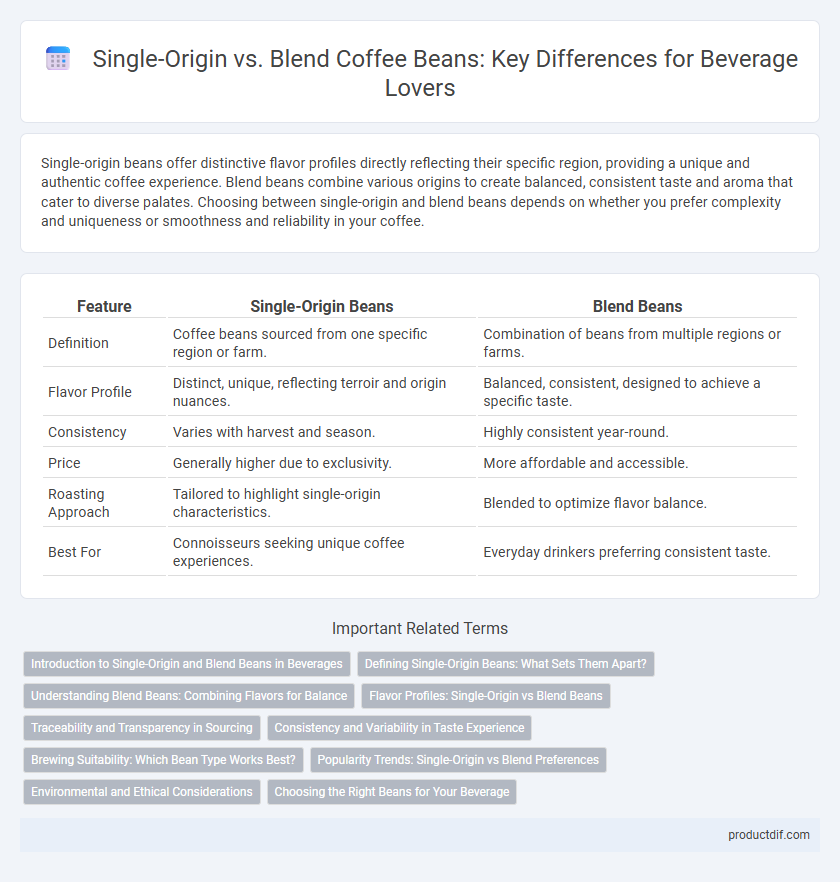Single-origin beans offer distinctive flavor profiles directly reflecting their specific region, providing a unique and authentic coffee experience. Blend beans combine various origins to create balanced, consistent taste and aroma that cater to diverse palates. Choosing between single-origin and blend beans depends on whether you prefer complexity and uniqueness or smoothness and reliability in your coffee.
Table of Comparison
| Feature | Single-Origin Beans | Blend Beans |
|---|---|---|
| Definition | Coffee beans sourced from one specific region or farm. | Combination of beans from multiple regions or farms. |
| Flavor Profile | Distinct, unique, reflecting terroir and origin nuances. | Balanced, consistent, designed to achieve a specific taste. |
| Consistency | Varies with harvest and season. | Highly consistent year-round. |
| Price | Generally higher due to exclusivity. | More affordable and accessible. |
| Roasting Approach | Tailored to highlight single-origin characteristics. | Blended to optimize flavor balance. |
| Best For | Connoisseurs seeking unique coffee experiences. | Everyday drinkers preferring consistent taste. |
Introduction to Single-Origin and Blend Beans in Beverages
Single-origin beans are sourced from a specific geographic region, offering unique flavor profiles that reflect their distinct terroir and cultivation methods. Blend beans combine coffee from multiple regions to create a balanced, consistent taste tailored to diverse palates and preparation styles. The choice between single-origin and blend beans influences the beverage's aroma, acidity, and complexity, catering to different consumer preferences and brewing techniques.
Defining Single-Origin Beans: What Sets Them Apart?
Single-origin beans come from a specific geographic location, often a single farm or estate, which imparts unique flavor profiles linked to that region's soil, climate, and cultivation methods. These beans offer distinct taste characteristics that highlight subtle nuances such as floral, fruity, or earthy notes, making them prized for their traceability and purity. Unlike blend beans, which combine multiple sources to achieve a balanced flavor, single-origin coffee celebrates the singular terroir and craftsmanship specific to one location.
Understanding Blend Beans: Combining Flavors for Balance
Blend beans combine coffee from multiple origins to create a balanced and complex flavor profile that highlights the best characteristics of each variety. This approach allows roasters to tailor the taste experience by mixing beans with complementary flavor notes, acidity, and body, resulting in a smoother and more consistent cup. Blended beans are favored for their versatility and ability to maintain flavor stability across different batches and brewing methods.
Flavor Profiles: Single-Origin vs Blend Beans
Single-origin beans offer distinct flavor profiles that reflect the unique terroir, showcasing vibrant, bright, and complex notes such as floral, fruity, or acidic characteristics. Blend beans combine multiple origins to create a balanced, consistent flavor with harmonious undertones, often emphasizing smoothness and richness. Roasters use blending to enhance body and reduce acidity, appealing to those seeking a versatile cup.
Traceability and Transparency in Sourcing
Single-origin beans offer superior traceability and transparency, as their exact farm or region of origin is clearly identified, allowing consumers to verify sourcing practices and ethical standards. Blend beans, while often crafted for complex flavor profiles, can obscure precise sourcing details, complicating efforts to trace back to specific farms or production methods. Transparent labeling of single-origin beans supports informed consumer choices by highlighting sustainable and fair trade practices in the beverage supply chain.
Consistency and Variability in Taste Experience
Single-origin beans provide a distinct and unique flavor profile reflecting their specific geographic origin, resulting in subtle variations between harvests that can enhance the tasting experience. Blend beans offer a consistent and balanced flavor by combining multiple bean varieties, ensuring uniformity in taste across different batches. This consistency is preferred by consumers seeking a reliable and predictable coffee flavor.
Brewing Suitability: Which Bean Type Works Best?
Single-origin beans offer distinct flavor profiles that highlight the unique characteristics of a specific region, making them ideal for brewing methods that emphasize clarity and complexity, such as pour-over or Chemex. Blend beans combine multiple origins to create balanced flavors, resulting in a more consistent taste across brewing methods like espresso and drip coffee. Choosing between single-origin and blend beans depends on desired flavor intensity and brewing technique, with single-origin preferred for nuanced tasting and blends favored for versatility.
Popularity Trends: Single-Origin vs Blend Preferences
Single-origin coffee beans have seen a surge in popularity due to their unique flavor profiles and traceability, appealing to specialty coffee enthusiasts seeking authentic taste experiences. Blend beans remain favored in mainstream markets for their balanced flavor and consistency, often providing a cost-effective option for daily consumption. Market analysis shows growing consumer interest in single-origin options, especially among younger demographics who prioritize quality and sustainability.
Environmental and Ethical Considerations
Single-origin coffee beans often support sustainable farming practices by promoting biodiversity and allowing farmers to maintain traditional agricultural methods, which can lead to better environmental stewardship. Blend beans, sourced from multiple regions, may pose challenges for traceability but can offer economic stability to a wider range of farmers, helping to ensure fair wages across different communities. Ethical considerations emphasize transparency in sourcing, with consumers increasingly favoring single-origin labels for their clearer impact on ecological footprint and supply chain accountability.
Choosing the Right Beans for Your Beverage
Selecting single-origin beans offers distinct flavor profiles unique to specific regions, ideal for beverage enthusiasts seeking clarity and terroir expression. Blend beans combine multiple origins, balancing acidity, body, and aroma to create a consistent, harmonious taste in your beverage. Understanding the flavor complexity and intended beverage style guides the choice between single-origin and blended beans for optimal enjoyment.
Single-origin beans vs Blend beans Infographic

 productdif.com
productdif.com